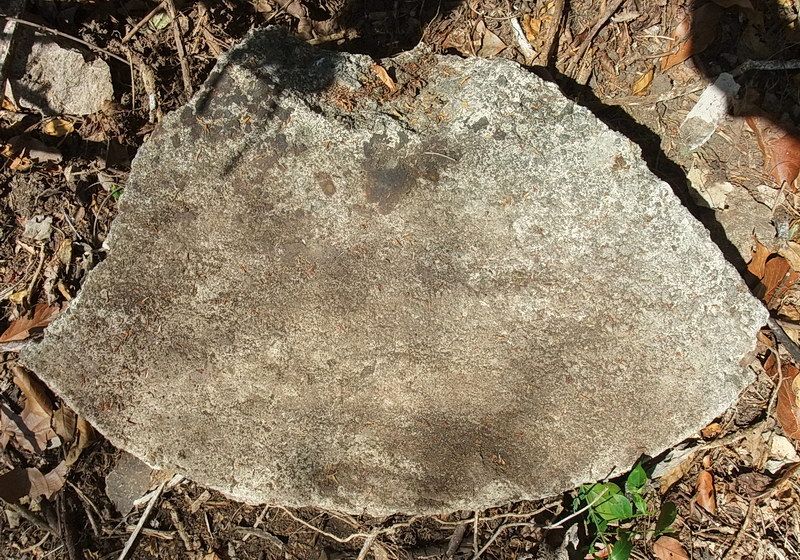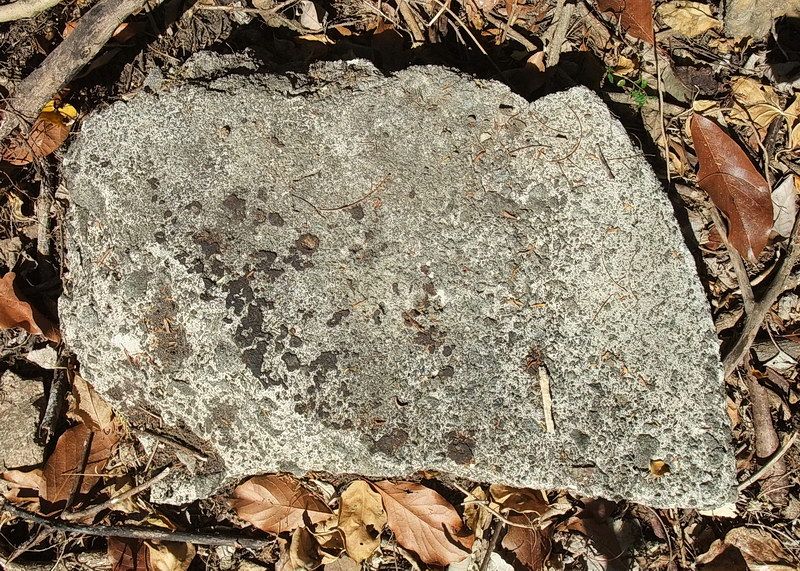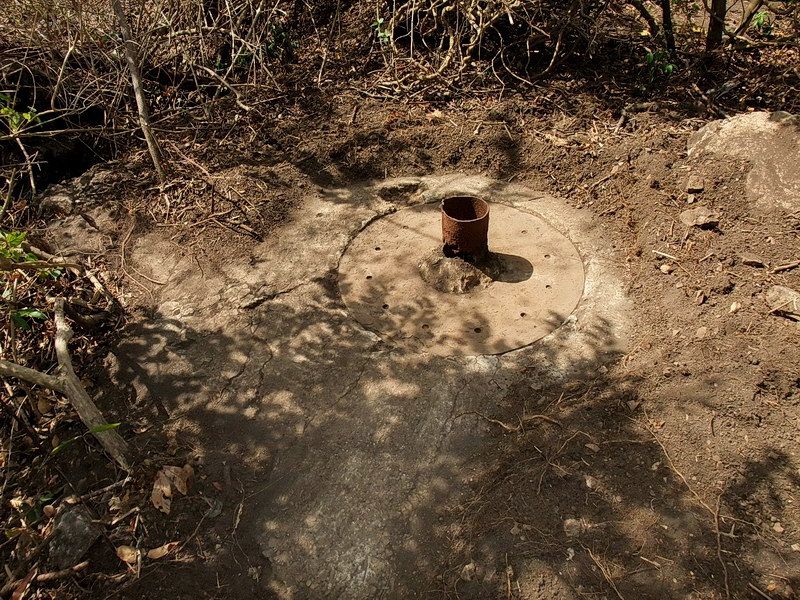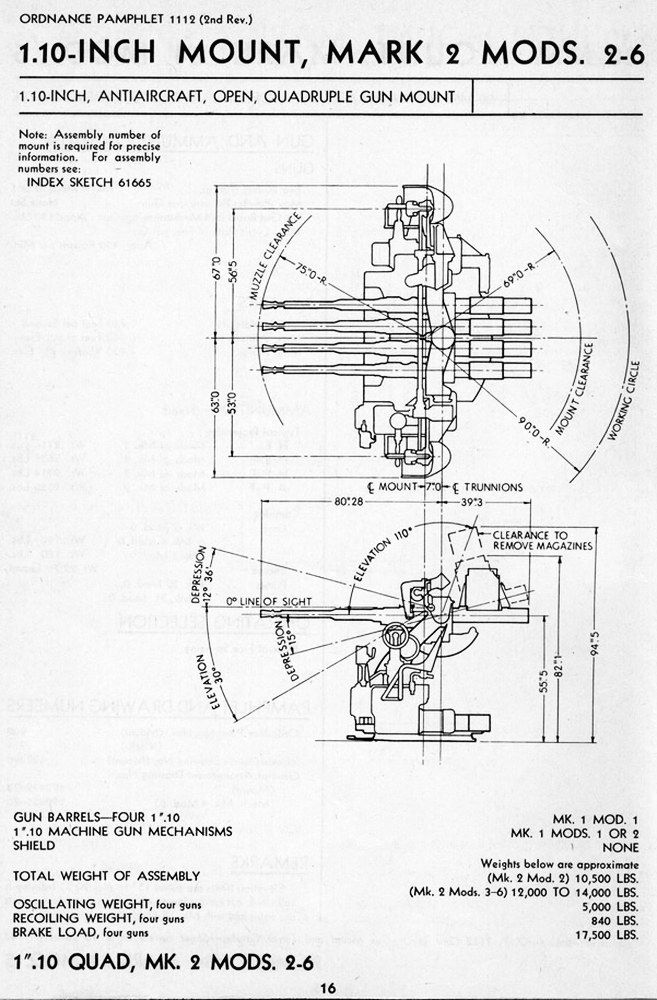|
|
Post by fots2 on Apr 6, 2013 19:22:09 GMT 8
Hi Chad, Two days ago I was on Malinta Hill. One final item to take care of was to have a look at the bottom of the two rounded pieces of concrete that had surrounded the metal pipe. Do the pieces have bolt size indentations on the bottom which would have been created if a ring of bolts had been sticking up? For better or worse, the answer is no, the bottoms are flat concrete. We have learned quite a bit about this pom pom but it seems that there will always be some mysteries.   |
|
|
|
Post by chadhill on Apr 7, 2013 1:56:14 GMT 8
Fots, thanks for checking out the pom-pom site once more. A possible explanation for the lack of bolt indentations on the bottom of the concrete pieces is that the mounting holes in the pom-pom's lower base ring may have been machined to accept counterbore bolts. The bolt heads, being flush with the surface of the ring, would then not interfere with a spacer that could have been between the lower base ring and the larger ring immediately above:  The larger ring looks to have at least a couple of holes bored thru it, too. Were they for bolts attaching a part between the two rings, such as a spacer? I've wondered if the concrete pieces you found at the mounting site were from a make-do substitute for a missing spacer. Probably poured into a mold, they are dome shaped on top, and the larger pom-pom ring seems to be dome shaped on the bottom, too. While the concrete pieces do not have any bolt holes, they would have been held in place by fit around the center pipe and between the rings. Of course, without a manual this is all a SWAG. (P.S.- It's too bad the rest of the concrete pieces aren't around. I wonder if their sum total would produce an off-centered part that evenly straddles the circumference of the round pad plate). I've looked often at the great panorama you put together from the newsreel stills. It nearly convinced me beyond doubt that the heavy weapon could not have been blown completely over by a bomb blast, because there seems to have been no damage to the flimsier structures nearby. Even if the gun was not bolted to its mount, which I seriously doubted (and still do).  Note that I said "nearly". While once again studying the cropped closeup of the base ring for this posting, I suddenly noticed what may be three bolt heads above their respective mounting holes:  The 64,000 dollar question is: IF these are indeed bolt heads, are they from broken-off bolts, or from bolts that have been backed out (partially unscrewed)? The one on the right does seem to extend out. I have looked at the photos of the mounting pad plate but cannot tell if there are any broken bolt studs left deep down in the holes, which may be filled with dirt. There are no broken studs extending down from the pom-pom's base ring, and none extend out of the pad plate in your photo below:  I think that if those are indeed bolt heads shown in the enlarged pom-pom base ring photo, and if no broken studs are down inside the pad plate holes, then it's likely that the bolts were backed out or unscrewed from the pom-pom. And by the Japanese. Some big ifs here, I know...yet another SWAG!  |
|
|
|
Post by fots2 on Apr 7, 2013 10:26:46 GMT 8
Good analysis there Chad. Like you, I believe that the pom pom was bolted down somehow. The offset pipe is a mystery but we do not have any technical manuals to show how an actual mount would have been constructed. I can tell you that the bolt holes in the ring embedded in the concrete pad are not empty. Using my picket knife I tried to clear out a few of them but fine sand and rusted metal fragments did not give me a clear view of what was there. My 2 inch long knife blade does hit something hard in the holes though. A rubber squeeze bulb of some sort would blow the debris out of there. There may be jagged bolts sticking up a bit below the surface of the metal plate but I am not 100% sure of this. I just zoomed in on one of my photos to look at the bolt holes in the metal plate. All appear to be full of fine rubble except one of them. With a little imagination, I can see the side of a severed bolt. When you two come here  we will go check it out together.  Note the upper left bolt hole. |
|
|
|
Post by chadhill on Apr 8, 2013 7:17:39 GMT 8
Fots, you have some very good equipment there. I think I may even be able to make out the rusted remains of threads in the sides of those holes. Any SWAG as to what the bolt diameter may have been? Or of the thickness of the mounting ring itself? Of the ring's diameter, and the diameter of the bolt pattern? Sorry to flood you with so many questions, if you don't have answers that's fine.  (photo courtesy fots2)  Do you recall if this photo was taken in the morning? If so, the pipe shadow would be pointing approximately west. The fractured concrete in the upper left corner would then be roughly to the N/NE. I mention this because the 240mm round that blew up inside the Searchlight #8 air shaft would have exploded roughly from that direction relative to the pom-pom gun. Also, in the Japanese PEF photo as well as in your panorama stitch the overturned pom-pom appears upset approximately on a NE/SE line. Just exploring a possible SWAG here... I have a wild SWAG as to why there is a "keyhole" cut out in the upper right corner. Maybe the Japanese tried to dislodge the mounting ring, embedded in concrete, from here with a wedge? The elusive pom-pom...and its many mysteries... |
|
|
|
Post by fots2 on Apr 16, 2013 15:46:18 GMT 8
Sorry for the late reply Chad, I was away on a family vacation. Yes those do appear to be threads visible in the sides of the holes. In places where the concrete is broken a bit, I can see that the metal ring is relatively thick (at least 1 inch). I cannot see the bottom of the ring so do not know the exact thickness. I did not take any measurements so have no other answers for you. The photo you asked about was taken at 10:50am. Here is another photo with a wider view. It was taken at 10:24am.  East is to the left, south is almost straight ahead. The sun is shining from the top left corner of the photo so coming from about south-east. The SL#8 air shaft is behind me. The pom pom gun would have been lying on its side at the top of the photo. I hope this helps. |
|
|
|
Post by fots2 on Apr 18, 2013 18:32:34 GMT 8
This drawing is not overly useful but I will add it here anyway.  |
|
|
|
Post by chadhill on Apr 19, 2013 8:12:15 GMT 8
Fots, thanks for verifying that the pipe shadow was cast in the morning. I'm pondering a possible future SWAG using that info, but will put it on the shelf for the time being... I was looking over your other photos of the pom-pom mounting site again, and was struck by something in this one: (photo courtesy fots2)  Notice the two "chips" in the upper concrete part that you and Phantom found. Now compare those chip locations and the rounded-on-top, flat-on-bottom shape of the end of that part, with the part seen in the Japanese PEF photo below. Though viewed from a slightly different angle, it seems to bear a resemblance.   Weren't the concrete parts you discovered found about where they are seen in your photo? If so, they would seem to be on the SW side of the steel mounting ring. The part shown in the PEF photo is roughly on the west side of the overturned pom-pom and thus probably W/SW of the mounting site. If this is indeed the same concrete part in both photos, it would open up even more new SWAGs  . But then again, I could just be seeing pink elephants...  * * * * * Thanks for posting the ordnance pamphlet diagram of the 1.1 inch gun. Pdh54 showed me this data sheet which has some very interesting info about the weapon, too.  |
|
|
|
Post by fots2 on Apr 19, 2013 20:36:55 GMT 8
Considering the pipe and the direction in which we are looking in the Japanese PEF photo, the piece of concrete you identified in that photo is nearly identical to the location of the concrete parts that we found. We may be seeing the same piece of concrete is the 1942 and 2013 photos. Your eagle eyes are in top form! In the first photo you posted today, we had not moved the pieces yet, that is where they originally sat.
|
|
|
|
Post by pdh54 on Apr 20, 2013 4:20:57 GMT 8
Hi Fots,
I've been wondering....
I am looking at that tall pipe in front to the toppled pom pom. It has a curved piece of concrete?/something abutting it on the left. If the other piece of concrete that has been flung to the right, the one you and Chad have been looking at, was originally part of a base around that pipe, can you hazard a guess as to what that pipe vents or is for? What is deeper under the hill?
It doesn't seem that it is venting the magazine, wrong position. Could it be a vent of some sort for the hospital or Malinta Tunnel? Is there anything under that part of the hill that we know of? It looks like it was important enough to be buttressed by concrete.
I am assuming you guys did not find any trace of a pipe in the ground over by the concrete pieces. I wonder if the Army would have had something sticking up 2 ft or so, so close to the pom pom.
Another guess......Could that concrete corner shown in the picture Chad has labeled with concrete chips, be part of the magazine or is it probably just part of a larger foundation for the pom pom?
Thanks
Patty
|
|
|
|
Post by The Phantom on Apr 20, 2013 20:58:01 GMT 8
Seeing the chunks of concrete in each picture chad really ties time together as Fots states, having held that concrete seems more important now with the new knowledge of it's history.
I don't think the cut out concrete along the edge of the metal base was there because someone was trying to pry up the metal base. It seems purpose built for some function.
I have seen similar concrete work by a gun location before but can't recall where.
Also in reference to one of Chads previous photo shots this thread, page 19, he shows the condition of the Instrument Storage Casement, #340 on the 1936 map, on Bottomside near the mine facilities.
On his photo, the building in question is just under the "Magazine Front Entrance" label in red.
If you now go to page 18 of Misc. Travels on Corregidor thread you will see 3 photos taken by Fots, of this Casement as it looks today.
Today's photo by Fots shows the only blast windows we've seen up to now on Corregidor.
Why are they still in place?
Chads picture this thread shows why.
The back and side of the Casement is buried by debris that slide down the hillside in 1945, and it was never cleared away as shown in photo's of today.
The Marsen Matting seen in one window was probably outside that window and buried there in 1945 also, but revealed as this particular blast window rotted away. Some of the rusted metal from the blast window is still visible at the bottom of the window frame.
Based on the looks of this building today it's hard to imagine that those windows opened to open space.
|
|